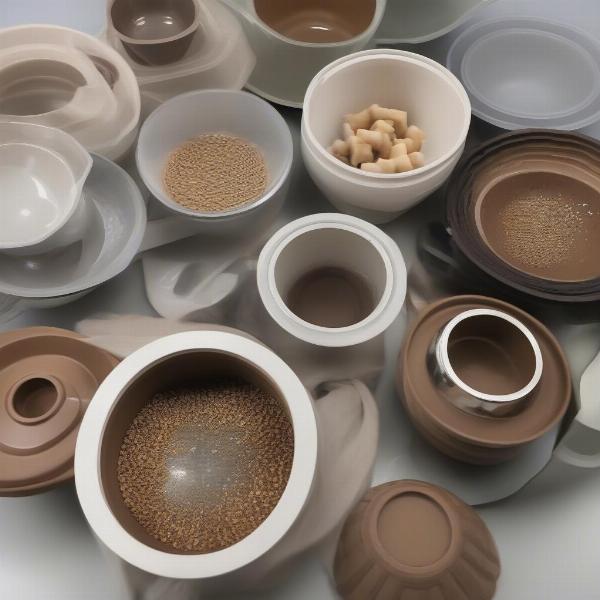Slow feeder bowls are a simple yet effective solution for dogs who gobble down their food in seconds. This rapid eating habit, known as bolting, can lead to a variety of health problems, including vomiting, choking, and even a life-threatening condition called bloat. A slow feeder bowl encourages slower eating, promoting better digestion and overall well-being for your canine companion.
Why Use a Slow Feeder Bowl?
Does your dog inhale their food rather than eat it? If so, you’re not alone. Many dogs, regardless of breed or size, are prone to bolting their food. This can be caused by several factors, such as competition with other pets, past experiences with food scarcity, or simply an enthusiastic love of mealtime. Slow feeder bowls combat this by physically obstructing a dog’s access to all the food at once. The raised ridges and obstacles within the bowl force your dog to take smaller bites and work for their meal, significantly extending eating time.
 Various Slow Feeder Bowl Designs
Various Slow Feeder Bowl Designs
Benefits of Slow Feeders
Switching to a slow feeder bowl can bring about a range of benefits for your dog’s health and happiness. By slowing down mealtime, these bowls help prevent common problems associated with rapid eating:
- Reduced Risk of Bloat: Bloat, or Gastric Dilatation-Volvulus (GDV), is a serious condition where the stomach fills with gas and can twist, cutting off blood supply. Slow feeders help prevent this by reducing the amount of air swallowed during eating.
- Improved Digestion: Eating more slowly allows for better food breakdown and nutrient absorption.
- Weight Management: Slow feeders can help with weight control by promoting a feeling of fullness and preventing overeating.
- Mental Stimulation: The challenge of navigating the obstacles in the bowl provides a form of mental enrichment, keeping your dog engaged and entertained during mealtimes.
- Reduced Choking Hazards: Smaller bites decrease the risk of choking, especially for dogs who tend to gulp large pieces of kibble.
Choosing the Right Slow Feeder Bowl
Selecting the appropriate slow feeder bowl depends on your dog’s breed, size, eating habits, and any specific dietary needs. Consider these factors:
- Material: Slow feeder bowls are available in various materials, including plastic, stainless steel, and ceramic. Stainless steel is generally the most durable and hygienic option. slow feeder bowl for dogs are available in various designs.
- Size and Design: The bowl’s size should be appropriate for your dog’s breed and the amount of food they consume. The design should offer an appropriate level of challenge, not so difficult that it frustrates your dog, but enough to slow their eating down. slow feeder bowl for large dogs are designed specifically for larger breeds.
- Dishwasher Safe: Opt for a dishwasher-safe bowl for easy cleaning.
Introducing Your Dog to a Slow Feeder
Switching to a slow feeder should be a gradual process. Start by mixing some of your dog’s food in their regular bowl with a small amount in the slow feeder. This allows them to get accustomed to the new bowl and its challenges. Gradually increase the proportion of food in the slow feeder until they are comfortable eating exclusively from it.
Are Slow Feeders Right for Every Dog?
While slow feeders offer many advantages, they may not be suitable for all dogs. For example, dogs with dental issues or jaw pain might find it difficult to eat from a slow feeder. dog slow feeder bowl can be a great solution for most dogs. If you’re unsure if a slow feeder is appropriate for your dog, consult with your veterinarian. mess proof dog bowls can be a good alternative for some dogs.
Conclusion
Slow feeder bowls are a valuable tool for promoting healthy eating habits in dogs. They offer a simple and effective way to prevent bolting and its associated risks, contributing to better digestion, weight management, and overall well-being. By carefully choosing the right slow feeder and introducing it gradually, you can help your dog enjoy a more relaxed and beneficial mealtime experience. Consider switching to a slow feeder today and see the positive impact it can have on your furry friend’s health. dog slow eating bowls can significantly improve your dog’s mealtime experience.
FAQ
- How do I clean a slow feeder bowl? Most slow feeders are dishwasher safe, making cleaning a breeze. Hand washing with warm, soapy water is also an effective method.
- Can puppies use slow feeders? Yes, slow feeders are beneficial for puppies as they establish healthy eating habits early on.
- What if my dog gets frustrated with the slow feeder? Start with a simpler design and gradually introduce more challenging bowls as they adapt.
- Are slow feeders effective for all types of dog food? Slow feeders work well with both wet and dry food, although some designs may be better suited for one type over the other.
- Can a slow feeder help with my dog’s anxiety at mealtimes? Yes, the act of working for their food can be calming and reduce anxiety in some dogs.
- Are there any disadvantages to using slow feeders? In some cases, dogs might become frustrated, especially initially. Also, some bowls might be difficult to clean thoroughly.
- Where can I buy a slow feeder bowl? Slow feeder bowls are widely available at pet stores, online retailers, and veterinary clinics.
About ILM Dog
ILM Dog is your trusted international resource for all things dog-related. From breed selection and health care to training, nutrition, grooming, and product recommendations, we offer expert advice and practical guidance for dog owners worldwide. Our website covers a wide range of topics including slow feeder bowls and other accessories to enhance your dog’s well-being. For expert advice and personalized support, contact us at [email protected] or call us at +44 20-3965-8624. Visit ILM Dog today for all your canine needs.